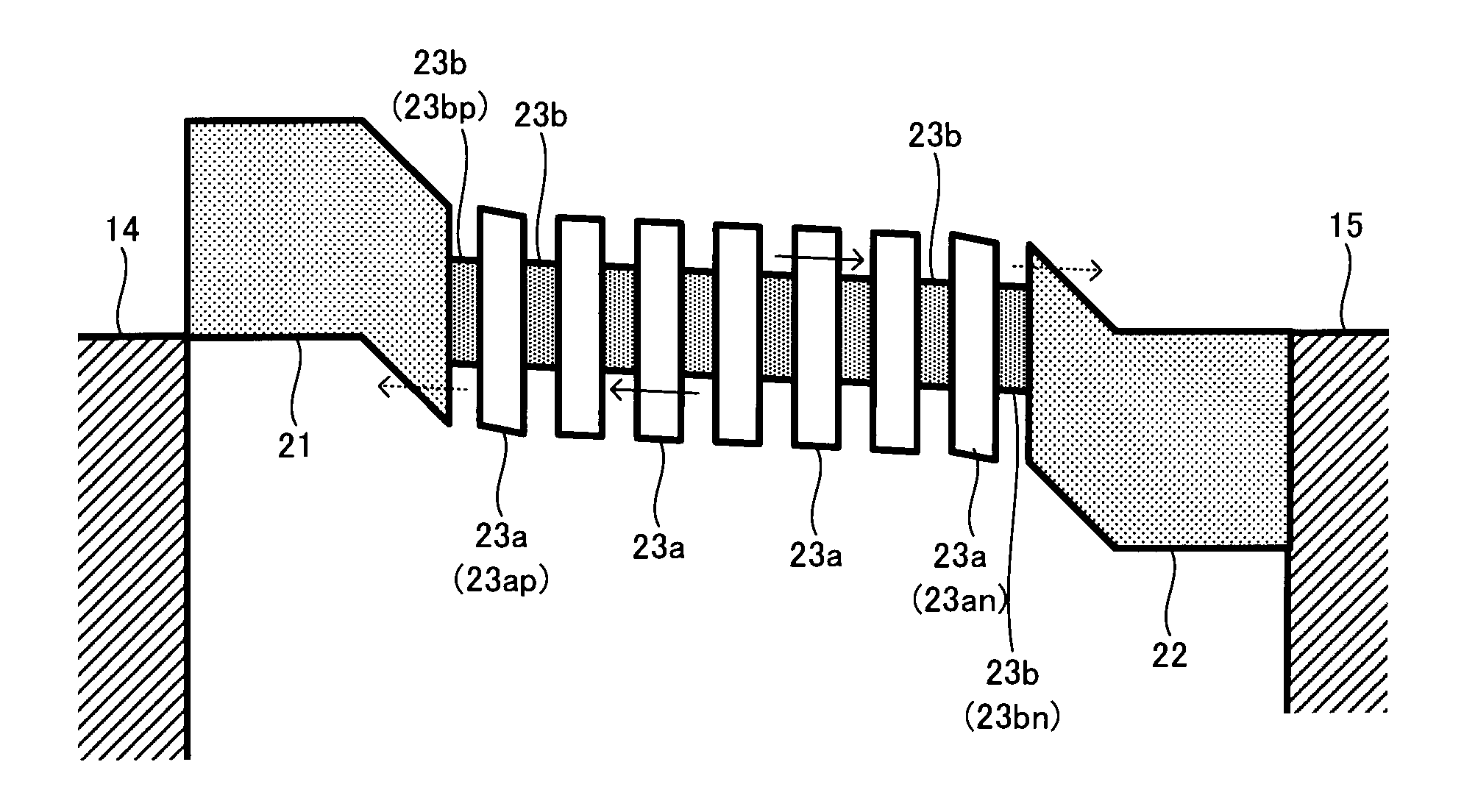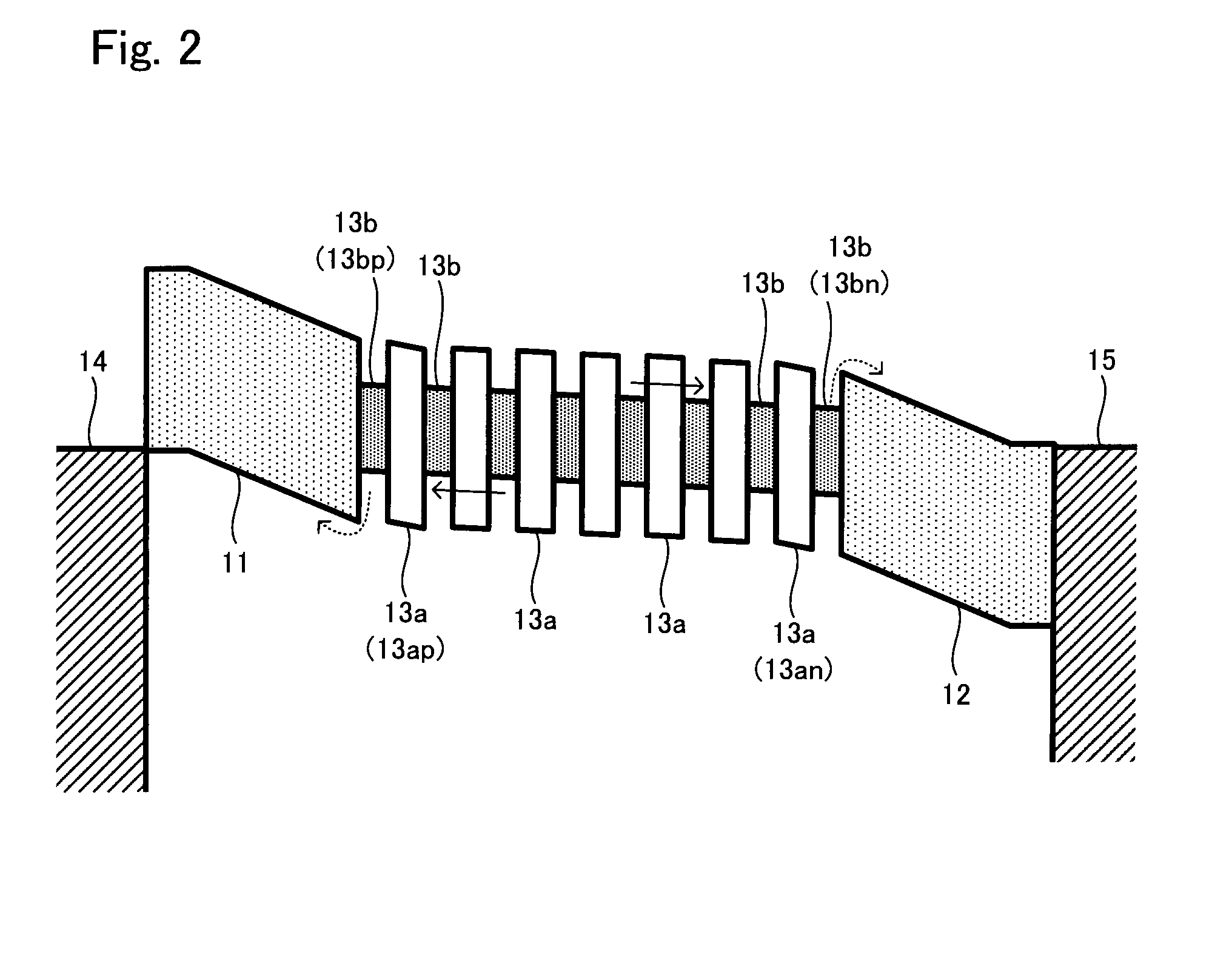Photoelectric conversion device
a conversion device and photoelectric technology, applied in the direction of semiconductor devices, electrical devices, nanotechnology, etc., can solve the problem of the theoretical limit of the photoelectric conversion efficiency of the mono-junction solar cell, which remains at about 30%, and achieve the effect of reducing the energy difference between the quantum levels of adjacent quantum structure portions, easy transfer, and easy transfer
- Summary
- Abstract
- Description
- Claims
- Application Information
AI Technical Summary
Benefits of technology
Problems solved by technology
Method used
Image
Examples
first embodiment
1. A First Embodiment
[0103]FIG. 1 is a cross-sectional view illustrating a solar cell 10 in accordance with a first embodiment. Some of the reference numerals are omitted in FIG. 1. As shown in FIG. 1, the solar cell 10 comprises: a p-layer 11; an n-layer 12; an i-layer 13 disposed between the p-layer 11 and the n-layer 12; a first electrode 14 connected to the p-layer 11; and a second electrode connected to the n-layer 12. The i-layer 13 comprises a wall layer 13a and quantum dots 13b, 13b, . . . , (sometimes simply referred to as a “quantum dot 13b”, hereinafter) disposed in the wall layer 13a. The wall layer 13a is constituted by a first semiconductor; and the quantum dots 13b, 13b, . . . are constituted by a second semiconductor having a band gap narrower than that of the first semiconductor. In the solar cell 10, a spacing among the quantum dots 13b, 13b, . . . is configured to permit a carrier to be transferred by tunneling conduction. An n-type impurity is contained in the wa...
second embodiment
2. A Second Embodiment
[0115]FIG. 3 is a cross-sectional view illustrating a solar cell 20 in accordance with a second embodiment. Some of the reference numerals are omitted in FIG. 3. In FIG. 3, to the elements having the same structure as those in the solar cell 10, the same reference numerals as those used in FIGS. 1 and 2 are given, and the explanations thereof are adequately omitted.
[0116]As shown in FIG. 3, the solar cell 20 comprises: a p-layer 21; an n-layer 22; an i-layer 23 disposed between the p-layer 21 and the n-layer 22; a first electrode 14 connected to the p-layer 21; and a second electrode 15 connected to the n-layer 22. A concentration of a hole contained in the p-layer 21 is higher than that of the hole contained in the p-layer 11 of the solar cell 10; and a concentration of an electron contained in the n-layer 22 is higher than that of the electron contained in the n-layer 12 of the solar cell 10. The i-layer 23 comprises a wall layer 23a and quantum dots 23b, 23b...
third embodiment
3. A Third Embodiment
[0123]FIG. 5 is a cross-sectional view illustrating a solar cell 30 in accordance with a third embodiment. Some of the reference numerals are omitted in FIG. 5. In FIG. 5, to the elements having the same structure as those in the solar cell 20, the same reference numerals as those used in FIGS. 3 and 4 are given, and the explanations thereof are adequately omitted.
[0124]As shown in FIG. 5, the solar cell 30 comprises: a p-layer 21; an n-layer 22; an i-layer 31 disposed between the p-layer 21 and the n-layer 22; a first electrode 14 connected to the p-layer 21; and a second electrode 15 connected to the n-layer 22. The i-layer 31 is configured in a manner laminating a wall layer 31a; a barrier 31b; and a layer 31e comprising a wet layer 31c and quantum dots 31d, 31d, . . . , (sometimes simply referred to as a “quantum dot 31d”, hereinafter). The wall layers 31a, 31a, . . . , (sometimes simply referred to as a “wall layer 31a”, hereinafter) are constituted by a fi...
PUM
 Login to View More
Login to View More Abstract
Description
Claims
Application Information
 Login to View More
Login to View More - R&D
- Intellectual Property
- Life Sciences
- Materials
- Tech Scout
- Unparalleled Data Quality
- Higher Quality Content
- 60% Fewer Hallucinations
Browse by: Latest US Patents, China's latest patents, Technical Efficacy Thesaurus, Application Domain, Technology Topic, Popular Technical Reports.
© 2025 PatSnap. All rights reserved.Legal|Privacy policy|Modern Slavery Act Transparency Statement|Sitemap|About US| Contact US: help@patsnap.com



